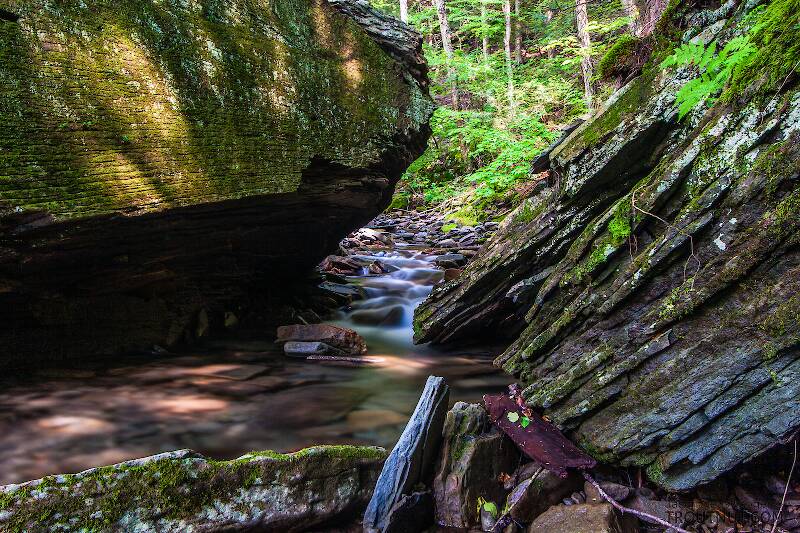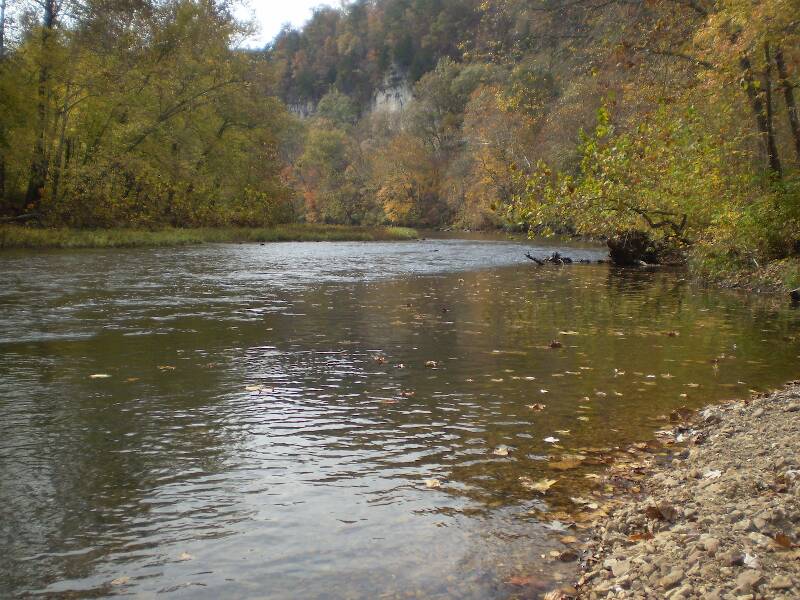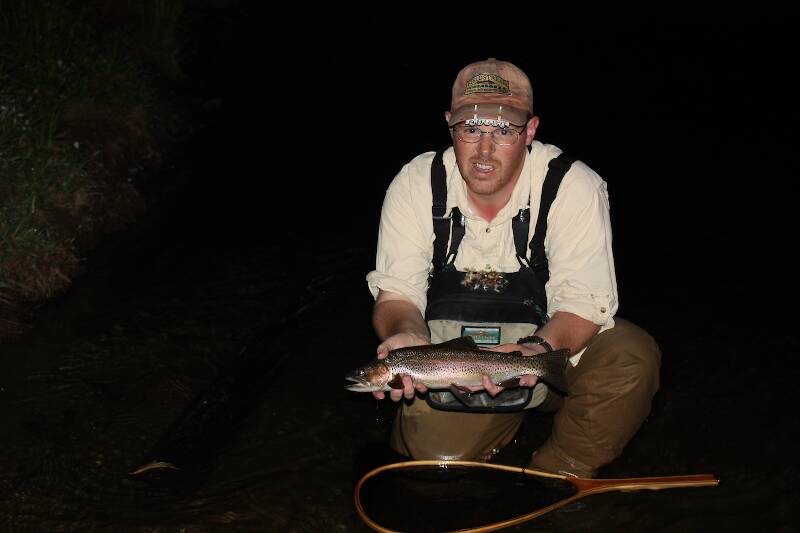
Salmonflies
Pteronarcys californica
The giant Salmonflies of the Western mountains are legendary for their proclivity to elicit consistent dry-fly action and ferocious strikes.
Featured on the forum

This specimen keys pretty easily to Onocosmoecus, and it closely resembles a specimen from Alaska which caddis expert Dave Ruiter recognized as this genus. As with that specimen, the only species in the genus documented in this area is Onocosmoecus unicolor, but Dave suggested for that specimen that there might be multiple not-yet-distinguished species under the unicolor umbrella and it would be best to stick with the genus-level ID. I'm doing the same for this one.

Troutnut is a project started in 2003 by salmonid ecologist Jason "Troutnut" Neuswanger to help anglers and
fly tyers unabashedly embrace the entomological side of the sport. Learn more about Troutnut or
support the project for an enhanced experience here.
Jmd123 on Jun 9, 2011June 9th, 2011, 6:39 pm EDT
Today I decided that, before the tourists show up for the weekend (especially the drunken canoers!), I should hit one of my favorite old spots on the Rifle River. I decided I needed to do more dry-fly fishing but, as my dry-fly supply was depleted earlier in the season by a series of fly-eating trees (somewhat like the old "kite-eating tree" from Charlie Brown), I didn't have a lot to choose from. Earlier in the week I threw a Female Adams, size 12 (I think, might be size 10), around on the Pine River because I had a few nice fresh ones I tied last year, and it got some hits there from fish I couldn't hook (likely little brookies). So on went one today on the Rifle - and in spite of seeing no more than a half-dozen or so insects in over four hours of fishing, I caught 7 brown trout, lost two more, and had probably 50 hits from little guys I couldn't hook! A hatchless feeding frenzy! I never could figure out why I saw so darned many rises or what exactly they were hitting, but they took the Female Adams with abandon and I don't think I ever went more than 5-10 minutes without a hit the whole time. The fish ranged from a couple in the 6-7" range up to a 12-incher, most being around 10 inches. All of them bent the 7 1/2-foot 3-weight over nice and hard! Both the air and water temps were around 61 F, most comfortable for the trout and this troutnut who was chasing them.
By golly, I'm going to tie up some more of these!! I'm wondering if the success of the pattern in a hatchless environment is due to the combination of subdued natural colors - brown and gray - with a bright contrasting spot of yellow on the tail end. The Adams is, after all, kind of the "Woolly Bugger of dry flies" - it doesn't imitate anything in particular but just looks good and buggy. Maybe the bright spot just adds enough trigger to set them off. Well, I'm gonna tie up some more with various colors of egg sac - yellow like the original, but also orange, chartruese, and maybe hot pink - and try them when there's nothing hatching. Geez, this might just replace my old favorite Royal Wulff as my go-to attractor dry fly!
And as if this fabulous day of trout fishing weren't enough, I saw a whole bunch of pink lady's slipper orchids, big ones over a foot tall, blooming in groups of up to five, on the walk back to my car, along with some really impressive big white and red pine trees. Then driving home I had to slam on the brakes and put on the hazard flashers because I saw two big beautiful yellow lady's slippers blooming right next to the road! Got some really nice photos of them and some other wildflowers as well.
LIFE IS GOOD!!!
Jonathon
By golly, I'm going to tie up some more of these!! I'm wondering if the success of the pattern in a hatchless environment is due to the combination of subdued natural colors - brown and gray - with a bright contrasting spot of yellow on the tail end. The Adams is, after all, kind of the "Woolly Bugger of dry flies" - it doesn't imitate anything in particular but just looks good and buggy. Maybe the bright spot just adds enough trigger to set them off. Well, I'm gonna tie up some more with various colors of egg sac - yellow like the original, but also orange, chartruese, and maybe hot pink - and try them when there's nothing hatching. Geez, this might just replace my old favorite Royal Wulff as my go-to attractor dry fly!
And as if this fabulous day of trout fishing weren't enough, I saw a whole bunch of pink lady's slipper orchids, big ones over a foot tall, blooming in groups of up to five, on the walk back to my car, along with some really impressive big white and red pine trees. Then driving home I had to slam on the brakes and put on the hazard flashers because I saw two big beautiful yellow lady's slippers blooming right next to the road! Got some really nice photos of them and some other wildflowers as well.
LIFE IS GOOD!!!
Jonathon
No matter how big the one you just caught is, there's always a bigger one out there somewhere...
PaulRoberts on Jun 10, 2011June 10th, 2011, 9:50 am EDT
LGBs (can substitute LBBs) trip trout bug receptors pretty well -a lot of the time. Should have floating and sinking versions and the basic presentation techniques --passive and active -- to run em with.
Jmd123 on Jun 10, 2011June 10th, 2011, 10:01 am EDT
"LGBs (can substitute LBBs)" - Paul, I'm not familiar with these abbreviations, could you please clarify? Thanks!
Jonathon
Jonathon
No matter how big the one you just caught is, there's always a bigger one out there somewhere...
PaulRoberts on Jun 10, 2011June 10th, 2011, 10:16 am EDT
LGB is "Little Gray Bastard" which comes from an amusing story told by Joe Humphreys. To paraphrase:
Some hatch-matchers are hanging around the woodstove at a riverside flyshop bemoaning the tough fishing, waders hung to dry, and trying to latinize their way to an answer. An old salt comes in with a bulging creel. "What did you catch them on!!" the group stammers. The old guy replies, "Why this little gray bastard here".
Some hatch-matchers are hanging around the woodstove at a riverside flyshop bemoaning the tough fishing, waders hung to dry, and trying to latinize their way to an answer. An old salt comes in with a bulging creel. "What did you catch them on!!" the group stammers. The old guy replies, "Why this little gray bastard here".
Oldredbarn on Jun 10, 2011June 10th, 2011, 10:37 am EDT
Paul,
Could be my waders hanging on that wall...;)
I never tire of that story...
My father was career Navy and worked his way up to quartermaster some-odd-class and was the navigator of the ship...They were doing a drill with a few other ships heading for Puerto-Rico in foggy weather...There were "college-boys" officer candidates on-board and one was chirping to my father from time-to-time that he wasn't always following procedures as written etc...The captain finally said, "You better leave Vandie alone or he'll drop us off somewhere in South America!"...Turns out that all but one missed the turn to Puerto-Rico and my father's ship pulled in alone in to the harbor.
An aside...When I was a lad in Norfolk VA I was allowed to visit the ship when it was in port on my Easter break...This is somewhere between 1st & 3rd grades...My father was instructing a young sailor in how to use a sexton...In my little guys brain I heard something about shooting stars and returned to school to tell the boys on the recess field that my pop could shoot stars out of the sky and I've seen the weapon he uses...
Spence
Could be my waders hanging on that wall...;)
I never tire of that story...
My father was career Navy and worked his way up to quartermaster some-odd-class and was the navigator of the ship...They were doing a drill with a few other ships heading for Puerto-Rico in foggy weather...There were "college-boys" officer candidates on-board and one was chirping to my father from time-to-time that he wasn't always following procedures as written etc...The captain finally said, "You better leave Vandie alone or he'll drop us off somewhere in South America!"...Turns out that all but one missed the turn to Puerto-Rico and my father's ship pulled in alone in to the harbor.
An aside...When I was a lad in Norfolk VA I was allowed to visit the ship when it was in port on my Easter break...This is somewhere between 1st & 3rd grades...My father was instructing a young sailor in how to use a sexton...In my little guys brain I heard something about shooting stars and returned to school to tell the boys on the recess field that my pop could shoot stars out of the sky and I've seen the weapon he uses...
Spence
"Even when my best efforts fail it's a satisfying challenge, and that, after all, is the essence of fly fishing." -Chauncy Lively
"Envy not the man who lives beside the river, but the man the river flows through." Joseph T Heywood
"Envy not the man who lives beside the river, but the man the river flows through." Joseph T Heywood
Jmd123 on Jun 10, 2011June 10th, 2011, 11:07 am EDT
"Little Gray Bastard" - I love it!!! Definitely concurs with my fly-fishing philosopy, and reminds me of a couple of my favorite botanical terms:
LBM - "little brown mushroom" (of which there are many, many, many...)
DYC - "damned yellow composite" (a "composite" is a member of the daisy or aster family, of which all too many of them are yellow...)
Jonathon
LBM - "little brown mushroom" (of which there are many, many, many...)
DYC - "damned yellow composite" (a "composite" is a member of the daisy or aster family, of which all too many of them are yellow...)
Jonathon
No matter how big the one you just caught is, there's always a bigger one out there somewhere...
Motrout on Jun 10, 2011June 10th, 2011, 2:57 pm EDT
Sounds like a nice trip! I kinda laughed to myself when I read the part about getting hit by about 50 trout that were too small to take the fly, because that happens to me just about every time I go to one of my favorite little wild rainbow creeks. I am usually fishing with a good sized dry fly (there are some nice fish in there if you can pick through the little guys) and you can easily get a dozen or more strikes by baby trout before you get one big enough to take the fly.
I love using Adams (and especially Parachute Adams) as searching dries on Ozark creeks when nothing much is going on. I usually just use a #12 or a #14 (or occasionally a #16) and never change through the whole day if it's working reasonably well, which it almost always does. If the weather cools off some like the weather guys are saying, with any luck I'll be on one of those streams tossing Parachute Adams here in a couple days!
Actually Adams aren't my favorite dry fly though. My favorite is the Ausable Wulff, and I'm not really sure why. Of course it works great on the Adirondack streams it was intended for, and it works reasonably well for small stream trout around home, but it is far from the best fly in my box. It's just such a pretty fly that it's always the first thing I want to tie on. I'm told that fly fisherman aren't always rational, and I guess I'm no exception.
I love using Adams (and especially Parachute Adams) as searching dries on Ozark creeks when nothing much is going on. I usually just use a #12 or a #14 (or occasionally a #16) and never change through the whole day if it's working reasonably well, which it almost always does. If the weather cools off some like the weather guys are saying, with any luck I'll be on one of those streams tossing Parachute Adams here in a couple days!
Actually Adams aren't my favorite dry fly though. My favorite is the Ausable Wulff, and I'm not really sure why. Of course it works great on the Adirondack streams it was intended for, and it works reasonably well for small stream trout around home, but it is far from the best fly in my box. It's just such a pretty fly that it's always the first thing I want to tie on. I'm told that fly fisherman aren't always rational, and I guess I'm no exception.
"I don't know what fly fishing teaches us, but I think it's something we need to know."-John Gierach
http://fishingintheozarks.blogspot.com/
http://fishingintheozarks.blogspot.com/
JOHNW on Jun 12, 2011June 12th, 2011, 9:59 am EDT
I recently had a similar day on a a trib to a somewhat famous north central PA freestoner. A #12 gray wulf was responsible for an obscene number of brookies. Of course the average fish was only about 5 inches long.
The great part was most of the area was blown out due to the 4" of rain that fell in the span of 2 hours the night before. Then you have this lovely medium to large (for PA brookie streams) which was crystal clear!
JW
The great part was most of the area was blown out due to the 4" of rain that fell in the span of 2 hours the night before. Then you have this lovely medium to large (for PA brookie streams) which was crystal clear!
JW
"old habits are hard to kill once you have gray in your beard" -Old Red Barn
Sayfu
Posts: 560
Posts: 560
Sayfu on Aug 28, 2011August 28th, 2011, 5:13 am EDT
Somethin to think about when body color is being considered. Gary LaFontaine gave scientific understanding to body color in this respect. Think of the color of the rainbow, the spectrum. Red, orange, yellow, green, blue, indigo, and violet. As you move from red at the beginning to violet on the end, the colors become more visible in low light conditions. In the medium of water with all the particulate in the water, on a sunny day, and in clear water with a minimum of particulate, red stands out well, but is the first to fade given shady, low lt. conditions, or in murky water. That is when the bass guy, as an example, does well using purple, rubber worms. So when you think of the classic "Royal" patterns, the Royal Coachman dries, and wets that have produced well over the years, you are covering your basis. Fish the Coachman in the darker, shaded area, and it is the peacock green that enhances the fly, and draws the strike. Now fish it in the more open, bright light area, and the red comes to life, and can draw the strike. It could just be that the yellow shows up when the grey has faded, and that is why the Female Adams worked well. Red has longer wave lengths, and purple the shortest, and the longer wave lengths get filtered out first.
Quick Reply
Related Discussions
Topic
Replies
Last Reply






